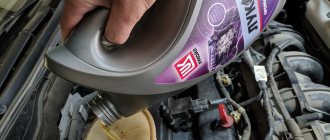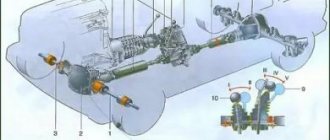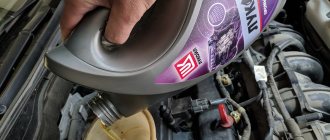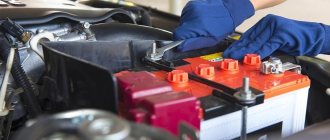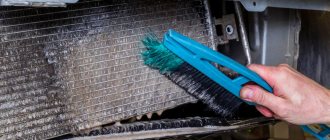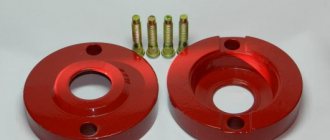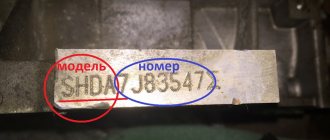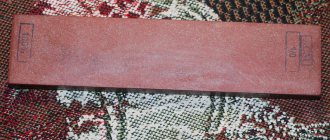Car Seam Sealant used during repair and installation work to protect the joints of various parts from the effects of corrosion and other harmful factors. Sealants are divided by composition, as well as type of application. In addition, they are divided into professional and popular. The former are usually sold in bulk packs and are used mainly in repair shops. The latter are sold in small, convenient packages and are intended for one-time use in DIY garage repairs.
Based on their composition, automotive seam sealants are divided into five types - silicone, acrylic, polyurethane, anaerobic and bitumen. According to the method of application, they are also divided into four types - sprayed, brush-applied, tape-sealants, and sealants in a tube. Each of the listed types has its own characteristics and can be used to implement specific purposes. At the end of this material there is a complete description of popular body sealants, a list of which you can find in the table.
| Name of sealant | Brief information and description | Package volume, ml/mg | Price of one package as of summer 2021, Russian rubles |
| Merbenit XS55 | One-component high-strength adhesive-sealant. It is very durable and can withstand shock and vibration. Protects from moisture and ultraviolet radiation. Can be painted. Available in white, gray and black. | 290 | 800 |
| Body 999 | One-component sealant based on rubber and synthetic resins. Can be painted. Please note that it is destroyed by ultraviolet radiation! Sold in a cartridge and a jar for a brush. | 1 kg | 470 |
| ZM 08537 | Sealant for application by brush. Resistant to process fluids and moisture. After drying it can be painted. Sold in cartridges and jars. | 1 kg | 2000 |
| Teroson Terostat 9320 | Sealant with a spray system, applied using a gun. Has noise-absorbing properties. Can be applied to varnished and clean surfaces. UV resistant. | 300 | 1000 |
| Novol Gravit 630 | One-component polyurethane sealant for sealing seams in metal. Resistant to moisture, ultraviolet radiation, and process fluids. Applying varnish is allowed 2 hours after sealing the seams with sealant. | 310 | 350 |
| Reoflex Brush Sealant | Suture hand sealant (applied with a brush). Has noise-absorbing properties. In air at a temperature of +20°C it dries in 6 hours. | 0.8 kg | 550 |
| APP PU-50 | White polyurethane one-component sealant. Can be used with various materials - metal, plastic, glass. Can be painted with enamel. | 310 | 260 |
How to choose joint sealant
Before you move on to choosing a sealant for the body, you need to decide on the answer to the question of what it is needed for. Even at the stage of body production in the factory, the manufacturer treats its surface with special compounds that are designed to protect it from minor mechanical damage and corrosion. This is especially true for various joints, recesses, welds and other transitional surfaces.
The use of body sealant in repair shops (or in garage conditions) is due to the same purposes. The only difference is the repair or replacement of any body part. The purpose of sealant for automobile body seams is to protect them from corrosion (both liquid and electrolytic), as well as minor mechanical damage.
Based on this, it is possible to formulate the criteria that the sealant chosen for purchase must meet. So, these include:
- Durability . The sealant should not lose its performance properties for as long as possible (ideally the entire service life of the machine).
- Elasticity . Many seams are curved rather than straight. Accordingly, in the frozen state, the sealant for car welds must be elastic. In addition, the car body is constantly subject to vibration while it is moving, therefore, under such conditions, the product must also perform its functions normally.
- High adhesion . These are properties of the sealant that allow it to adhere to the surface to which it is applied (and this is not always pure metal).
- Resistance to external factors . In particular, to the effects of moisture, ultraviolet radiation, technological automotive fluids (fuel, oil, brake fluid, washer fluid and others), overheating and hypothermia.
- Possibility of painting . All joint sealants are divided into those that can be painted (varnish applied to them) and those that cannot be painted.
The better the sealant for treating weld seams meets the listed requirements, the better the protection of both the seams themselves and the car body as a whole will be protected.
Purpose of sealants for car seams
The body assembly is a very vulnerable part in the design of the car. It can be damaged due to an accident, emergency situations, or negligence of the driver or passengers.
Don't know what sealant to use to seal the seams on your car? To do this, you need to understand their properties. Seam sealants are products designed to repair body damage. They insulate, seal and bond coverings. These products protect the treated area from moisture and rust formation.
Properties and characteristics
Sealant for sealing joints on a car has the following characteristics:
- Persistence. The applied material will not lose its properties even after prolonged use.
- Elasticity. The seam will be flexible, taking the desired shape.
- Adhesion to most coatings. Sets quickly. Compatible with metal and rubber.
- Resistance to moisture. Does not become limp under conditions of high humidity or direct contact with water.
What types of sealants are there?
All sealants for metal seams on automobile body parts can be divided into two categories - by composition and by application method. The method of application largely determines not only the ease of use, but also whether the product belongs to the professional class.
Division of sealants by composition
The mentioned products can be divided into the following five groups - acrylic, anaerobic, silicone, polyurethane, bitumen. We will describe them in the given order.
Acrylic compounds
They are based on polymer compositions. Such sealants have good adhesion, but their elasticity can be described as average. Accordingly, under strong mechanical loads and/or vibration, there is a risk that they will simply delaminate on their own and lose their properties. Accordingly, they are best used on rough surfaces (most seams are like this) and on stable mechanical components. Their strength is quite good. Acrylic sealants can be either varnished or painted.
Anaerobic sealants
Their peculiarity is that in their non-polymerized (not frozen) form they are a liquid. Accordingly, they can be poured into the smallest cracks and grooves. Their polymerization begins the moment their contact with oxygen (atmospheric air) ceases. Typically, anaerobic agents are used to seal welds in small areas or work in stages. The advantages of these compositions lie in the great strength of the resulting protective stain and its high protective properties. However, its elasticity is low. In addition, working with anaerobic sealant is not always convenient due to the fact that it spreads over an uneven surface.
Silicone sealants for body
One of the cheapest and most common means for garage body repair. They are easy to work with, simple to apply, they harden quickly and reliably protect welds from moisture and other harmful factors. In addition, silicone sealants for car body joints usually have a wide temperature operating range, which is why they work equally well in both summer and winter. The only drawback is that due to the fact that they have a thick consistency, they cannot tightly fill small grooves and cracks, as well as deep ditches on the part.
Polyurethane products
These sealants are the most widely used in the market due to their excellent performance characteristics. All this became possible due to the fact that they are easy to apply, have great strength, elasticity and durability. They withstand significant mechanical loads and vibrations, do not spread over vertical surfaces, have a wide temperature range, and reliably protect from moisture. Depending on the form of application, polyurethane sealants for car bodies can be sprayed or applied with a brush. Please note that all polyurethane sealants must be applied to a pre-primed surface.
Bitumen sealants
They are made on a bitumen basis and are a thick paste, usually black. Before applying them, the surface to be treated must be carefully prepared. Bituminous sealant is used to treat not only welds, but also large surfaces, for example, the underbody of a car. They protect well from moisture, road chemicals, small stones and debris. Apply either with a spray or with a brush.
Sealants for body seams according to application method
The next classification of sealants is based on the method of application and storage. According to this classification, they are divided into four classes.
Sprayable Sealants
These sealants are further divided into two types - one-component (immediately ready for use) and two-component, that is, those that must first be prepared for use. However, single-component ones are more common.
Such products are applied to the surface to be treated using a pneumatic gun. The composition is sealed under the influence of moisture in the air and forms reliable protection. Sprayable sealants are convenient for working on large areas, as well as in hard-to-reach places (for example, the underbody, wheel arches, remote seams and surfaces).
Brush applied
Typically, such sealants for welding seams are supplied in large-volume cans or canisters; accordingly, they are often used for treating cars in a car service center. Apply to a previously prepared surface using a brush. They can not only process welds, but also be used as a protective agent for the bottom of the car, wheel arches, and so on.
Sealant tape
This is a special tape, on one side of which an adhesive composition is applied, and on the other - a sealing compound. Accordingly, it needs to be glued along the seam that is supposed to be protected. The convenience lies in the fact that you don’t need to warm it up or take any additional actions - it hardens on its own and quickly enough. However, such tape is unlikely to be convenient for sealing long welds, especially if they have turns. Accordingly, it is best to treat small areas with sealant tape.
Extruded sealants
They are divided into two types - manual and “for pistol”, respectively, sold in tubes and cartridges. Hand pipes simply need to be opened, apply sealant to your finger or handy tool and apply to the surface to be treated. The cartridge is usually used with an air or mechanical gun. It is better to use manual sealant for car seams if the area to be treated is small. Gun - if you need to process a long seam.
Types of sealants
A sealant is a composition of oligomers or polymers that has a paste-like or viscous state. The intended use of these substances is waterproofing and sealing.
Today there are a large number of different types of sealants on the market. They not only differ in composition, but are also designed for gluing different surfaces under completely different operating conditions.
Sealants vary:
- By composition.
- By method of application.
The composition is usually divided into:
- Silicone sealants. These are moisture-resistant joints that can withstand fairly high temperatures and are capable of forming an elastic seam at the joint. Silicone compounds are also not homogeneous; they can be universal, silicate, that is, maximum heat-resistant, withstand up to 1200 degrees, auto repair and sanitary.
- Acrylic. The main distinguishing feature is its fairly high adhesion to various types of plastics. The seam also turns out to be elastic, but at this point it will be clearly inferior to the silicone version. They are chemically neutral and not resistant to moisture. When joining wood flooring, different colors of these sealants are usually used.
- Polyurethane or polyurethane foam.
- Bitumen. Typically used in construction.
There is also a division of compositions according to the main substance of the base and it is customary to distinguish:
- Anaerobic compounds. These compounds do not harden as long as they contain oxygen. Under normal conditions and without certain skills, it is extremely difficult to make repairs with their help.
- Silicone. This is the most suitable option for any work on sealing surfaces and car parts.
- Resin based. They are usually used for household repairs and extremely rarely for car repairs.
Adhesives and sealants can have different types of packaging from small tubes to fairly large tubes. When starting to work with sealing compounds, you should not buy containers that are too large - after 2-3 times of use, the remains usually have to be thrown away. Today, sealants often come in tubes with dispenser spouts, but professionals can use special guns. They can be either automatic or mechanical. If the seam needs to be applied very evenly, you can use a special butterfly attachment.
Rating of popular body sealants
The answer to the question that many car enthusiasts are interested in, which car seam sealant to buy, will be the following approximate answer - the most suitable one in terms of parameters. A list of the most popular sealants for body seams, compiled based on reviews and tests from the Internet. If you have used other means, write about it in the comments.
Merbenit XS55
Merbenit XS55 is positioned as a one-component high-strength adhesive-sealant designed for gluing parts with different thermal coefficients of thermal expansion. Operating temperature range - from -40°C to +90°C, application temperature - from +5°C to +40°C. The average value of the breaking load is 909.1 Newton, the average value of the breaking stress is 2.865 MPa.
Merbenit sealant is odorless, perfectly protects the surface from corrosion and ultraviolet radiation, withstands shock and vibration, has excellent adhesion, and is resistant to process fluids (oils and fuels). The sealant can be painted using the powder method, including when it has not yet hardened. Available for sale in three colors - white, gray, black.
Reviews of Merbenit XS55 body sealant are mostly positive. Cartridges with a volume of 290 ml are sold. As of summer 2021, the price of one such package is about 800 Russian rubles.
1
Body 999
Body sealant Body 999 9990300001 is a one-component composition based on rubber and various synthetic resins. Can be used for gluing body parts, filling voids, sealing welds and simply metal surfaces. It perfectly combines high strength and elasticity, so it does not lose its properties under the influence of vibration. Has excellent adhesion. After drying, the “Body” sealant can be painted using any methods and paints. Drying time at a temperature of +20°C...+25°C is about two hours. One of the features worth noting is that it cannot be used on open surfaces exposed to sunlight, since this sealant is destroyed by ultraviolet radiation.
Sold in a standard cartridge for a mechanical pistol, as well as in a large 1 kg can. The price as of the above period is about 470 rubles.
2
ZM 08537
Seam sealant ZM08537 is specially designed for application to the surface using a brush. They are used to process seams on the car body at the place where the shock absorbers are attached, body joints in the trunk and engine compartment, on the floor, and the inner parts of the doors. Designed for use with spot welded seams. Or for bolted connections.
It does not spread when applied. It must be applied to a previously cleaned and primed surface. Resistant to oils and process fluids. After drying, it does not lose elasticity. Drying time for painting is 1 hour for working with air-drying paints and 3 hours for working with hot-drying paints. Application temperature is from +5°C to +35°C, and the operating temperature range is from -25°C to +70°C.
It is sold in a 1 kg jar and 310 ml pistol cartridges. The price of a large package is about 2000 rubles.
3
Teroson Terostat 9320
Teroson Terostat 9320 from Henkel is a sealant with a spray system based on MS polymers. The composition hardens on the surface under the influence of moisture. After hardening, it looks like liquid rubber.
The sealant is polyurethane and does not contain silicones, PVC elements or isocyanates. The cured sealant has noise-absorbing properties. It can be applied to varnished surfaces (LPC), bare metal and primed surfaces. Compatible with alcohol-based varnishes. Resistant to ultraviolet radiation.
Sold in 300 ml cartridges. The price of one package is 1000 rubles.
4
Novol Gravit 630
Polyurethane sealant Novol Gravit 630 33201 is a one-component product designed for sealing joints, including welded and soldered seams on metal. It can be applied to a varnished, primed and prepared surface, which, however, must be washed, dried and degreased before application.
Shows high resistance to moisture, ultraviolet radiation, and chemical compounds. The optimal temperature for application is from +5°C to +35°C. Final polymerization with a layer thickness of 3...4 mm occurs after 24 hours. Applying varnish to the surface is allowed 2 hours after applying the sealant. Available in three colors - white, gray and black. Apply using a mechanical gun.
The volume of a standard cartridge is 310 ml. Its average price is 350 rubles.
5
Reoflex Brush Sealant
Reoflex Brush Sealant RX-P10 is a brush joint sealant designed for sealing seams in metal, concrete, and wood products, including welds during car body repairs. Has noise-absorbing properties. Well protects against corrosion. Resistant to fuel, oil, non-aggressive chemical liquids. Application temperature – from +15°С to +30°С. In air at a temperature of +20°C it dries in 6 hours. Before application, clean and degrease the surface.
Sold in a metal can weighing 0.8 kg. The price of such packaging is 550 rubles.
6
APP PU-50
APPPU-50 is a white polyurethane one-component sealant designed for sealing welds and various cavities. Can be used with various materials - metal, plastic, glass and even concrete. After polymerization it remains elastic. When finished, it can be painted with any type of enamel paint.
Sold in a standard 310 ml pistol cartridge. Its price is about 260 rubles.
7
3M sealant for car
3M sealants have long proven themselves in body repair. They have a large range of materials for various needs. Consider 3M 08684. This is a one-component polyurethane composition in gray (also available in black and white). Designed for processing seams around doors, joining panels, car floors, etc.
This 3M polyurethane body sealant has the following characteristics:
- Good to apply
- Doesn't spread
- Dries quickly
- After drying it has high hardness and elasticity
- Dries in harsh conditions (humidity, low temperature)
There are also 3M automotive body sealants for weld seams (welding seams), but as practice shows, it is still recommended to first treat them with acidic primer or epoxy.
Tips for applying sealant
Exact instructions for using sealant for automotive body seams are usually found on the packaging, less often in additional documentation. It is there that all the nuances of application are indicated. However, in most cases, the car owner must adhere to a few simple rules before and during the application of sealant. Among them:
- Prepare the surface to be treated . If the weld is fresh, it is advisable to clean it with a grinding tool and/or sandpaper in order to remove scale and sludge from it. If there is rust or small debris on the surface, you need to get rid of them. At the final stage, it is advisable to degrease the surface to be treated using body degreasers.
- Clean the surface to increase adhesion. Usually, special primer tapes or the so-called Scotch-Brite tape are used for this. However, this function does not need to be performed for all sealants.
- Perform priming . Before applying some sealants, it is necessary to apply a special primer to the surface.
- When applying sealant to vehicle welds along their length, it is necessary to maintain the same application speed in each area. This will make it possible to ensure the same layer thickness along the entire length, comparable to the factory one.
- Warm up before use . To make the sealant easier to squeeze out of the packaging, it is advisable to heat it to approximately +30°C...+50°C. This can be done, for example, by placing the closed package in a bucket of warm water.
- It is better to apply sealant into the gap in a “snake” and/or “Christmas tree” structure . To do this, the tube nose is cut at an angle of 45 degrees with a hole diameter of about 7...10 mm. You can use a hand gun.
If the sealant is applied to a place where there was already a similar composition before, then the previous layer must be carefully removed. But this must be done carefully so as not to damage the surface.
How to use (apply) automotive sealant?
The material itself can be applied without preliminary preparation, however, if the work is done correctly and a little “fuss”, you can get the highest quality, strong sealant seam.
We prepare everything you need. So that during work all the necessary tools and materials are at hand. This step will reduce the time spent searching in the garage, and at the same time save your nerves. Make sure you have a brush, spatula, degrease, a brush (a brush with metal rods for cleaning old paint and carbon deposits), dry rags for your hands, and a rag for wiping off the sealant if it gets in the wrong place. If you are using a plastic tube, then you also need a gun that will squeeze the sealant out of it.
We prepare the plane. If we need to seal a weld, then we put on safety glasses and use a metal brush to remove carbon deposits and pieces of scorched paint. Next, using a regular brush, scrape off as much residue as possible. Next, degrease the surface and wait a couple of minutes until it dries.
Primer. If you have a primer for metal, then you can prime our seam. This will only be a plus in your work. Typically, the primer dries quickly. The manufacturer should write about this on the packaging (drying time).
We apply sealant. The main thing is that if you use a pistole with a tube, do everything at the same speed and apply the material evenly over the entire seam. If you use a brush, apply evenly in one layer. After work, remove the excess with a spatula. Allow time to dry according to the instructions on the package.
How to remove body sealant
If for some reason the sealant could not be removed in the early stages, then there are a number of means by which this can be done later. Among them:
- Warm up with a hairdryer . The softened composition can subsequently be easily removed using available tools - a knife, screwdriver, and so on.
- Body degreasers or bitumen cleaners. There is a wide variety of them, so it is impossible to say for sure whether this or that remedy will help or not in a particular situation.
- White spirit, solvent . It is not advisable to use these compounds on paintwork, but you can use them on untreated metal. These are quite powerful tools that can soften hardened sealant. It can then be removed using a rag or knife.
- "Solvent 646", pure acetone . These are even more powerful tools; they can easily cope with most manufactured silicones and sealants.
If during the application process some of the sealant gets into a place where it should not be, it is necessary to get rid of it as quickly as possible simply using a rag or napkin before the composition dries. The sooner you do this, the easier it is to remove it!
Automotive sealant: how to achieve a good result?
Choosing the right sealant is an important step, which, however, is just the beginning.
It is also important to apply the product correctly so that the result is positive. Below we bring to your attention some useful tips for using auto sealant:
- Clean the surface thoroughly before applying the product.
- For better adhesion, you can pre-clean the application area, if possible.
- Be sure to degrease the surface and dry it thoroughly.
- If possible, use a special air gun - it ensures the most uniform application.
- Have a rubber spatula ready so you can quickly remove excess and trim the edges.
- Thickened silicone or polyurethane sealant can be diluted with anti-silicone. Use the substance also to prevent the sealant from stretching and sticking.
- Before painting the surface treated with sealant, no additional actions are required: just wait until it dries.
If it is necessary to remove the sealant, it must first be heated with a technical thermal blower or a regular hairdryer. It is worth removing the substance in small sections before it has time to cool. Be careful when working with plastic parts - do not overheat them! If the appearance of the surface is not critical, it is acceptable to cut off the sealant with a sharp knife.
It is worth understanding that we can only give general recommendations on the use of auto chemicals. However, sealant is different from sealant, and the properties of even similar products differ from manufacturer to manufacturer. Before starting work, you should carefully study the information on the packaging.
With an understanding of how to choose an automotive sealant, you can confidently begin searching for the right solution.
It’s convenient to choose automotive sealant and compare prices at Price.ua.
